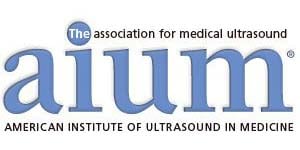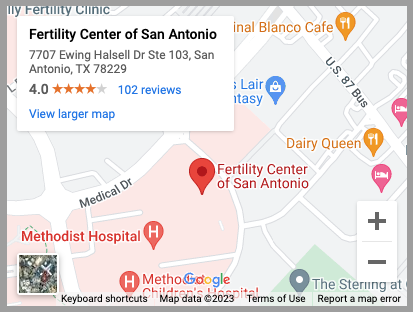Discover Your Path to Parenthood Today.
Preimplantation Genetic Testing:
PGT-A (formerly PGS) and PGT-M (formerly PGD)
It is possible to evaluate the genetic status of an embryo, produced by in vitro fertilization before the embryo is transferred into the woman’s uterus. We provide two types of preimplantation genetic testing at our San Antonio fertility center. Contact the Fertility Center of San Antonio to learn how this important testing may benefit you.
In both types, embryos produced by in vitro fertilization are grown for five or six days until they reach the blastocyst stage. At the blastocyst stage, the embryo is composed of two different kinds of cells: those that make the baby (inner cell mass or ICM) and trophoblast, cells that support implantation and help make the placenta. For genetic testing, we remove several of the trophoblast cells in our state-of-the-art Embryology Laboratory in a procedure called embryo biopsy. Those cells are prepared by our embryologists and are shipped to a specialty genetic testing laboratory for either preimplantation genetic testing for aneuploidy PGT-A (formerly PGS) or preimplantation genetic testing for monogentic/single-gene diseases, PGT-M (formerly PGD). The blastocysts are frozen until the genetic analysis is completed. Doctors at our center will review the genetics report and in consultation with the patients, advise as to which embryos are normal and available for embryo transfer.
PGT-A and PGT-M: What is the Difference?
Preimplantation genetic testing for aneuploidy (PGT-A) provides information about the embryo’s chromosomes whereas preimplantation genetic testing for monogentic/single-gene diseases (PGT-M) looks for the presence of a specific, disease-causing gene.
In PGT-A, embryos are screened for the presence and the correct number of every chromosome. Human chromosomes are numbered according to size with chromosome 1 being the largest, and cells of the embryo should contain a total of 46 chromosomes; two of every chromosome from 1 to 22 plus two X chromosomes for females or one X and one Y chromosome for males. Any variation of this, either an extra chromosome(s) or a missing chromosome(s), is an abnormality that can affect the ability of the embryo to live, grow and/or to implant when transferred. For certain cases, the presence of either an extra chromosome or the absence of one can be compatible with pregnancy and birth but will result in an affected child. Examples of this are Down Syndrome, produced by the presence of an extra chromosome 21, and Turner’s Syndrome, caused by the absence of one of the X chromosomes in females.
The Benefits of PGT-A (formerly PGS)
There are several important benefits of performing PGT-A. First, an embryo with the correct number of chromosomes has a significantly better chance of implanting in the uterus, thus increasing the chance of success for an in vitro fertilization procedure. This is particularly beneficial with increasing maternal age since women produce more chromosomally abnormal eggs as they age. Secondly, since pregnancy loss is often caused by chromosomal abnormalities, PGT-A can identify embryos that are more likely to result in miscarriage if transferred. Lastly, PGT-A can identify embryos carrying chromosomal abnormalities that are compatible with life but will produce an affected child.
In PGT-M, embryos are analyzed for the presence of a specific abnormal gene, one that can cause disease and is known to be carried by the parents or to be present in the family of the parents. There are many diseases caused by defects in single genes: hemophilia, spinal muscular atrophy, Tay Sachs Disease, Huntington’s Disease, cystic fibrosis, and sickle cell anemia are all examples. The procedure for PGT-M is the same as that for PGT-A and involves in vitro fertilization to produce embryos, followed by embryo biopsy of blastocysts. The biopsied samples are also prepared and sent to the genetics specialty laboratory, which has already acquired information about the parents, and their families in order to better identify the abnormal gene. The blastocysts are frozen until the genetic diagnosis for each embryo is made and doctors from our center then provide the patients with details of the analysis and advise as to which embryos are safe for transfer.
The Benefits of PGT-M (formerly PGD)
PGT-M has the ability to identify specific embryos that are either affected by a disease caused by a defect in a single gene or are carriers of the affected gene. By avoiding the transfer of affected embryos, patients can ensure that children resulting from IVF are free of the disease that plagues their families.
Can PGT-A and PGT-M Be Performed Together?
Yes, it is possible to evaluate the number of chromosomes along with the presence of a single gene defect in the same embryo.
It should be noted that some embryos may not reach the blastocyst stage or may not be suitable for biopsy.
Contact Us Today to Learn More
Even with the incredible advancement of modern reproductive technology, many patients still experience heartbreaking failures and are unable to understand why. If you have tried and failed to start a family, even with assisted reproductive services, speak with us about what PGT-M and PGT-A can do for you. By screening your embryo for genetic abnormalities, you can improve your chances of successfully becoming pregnant and giving birth to a strong, healthy baby. To learn more about the innovative ways our team is able to address infertility, contact our office today.











